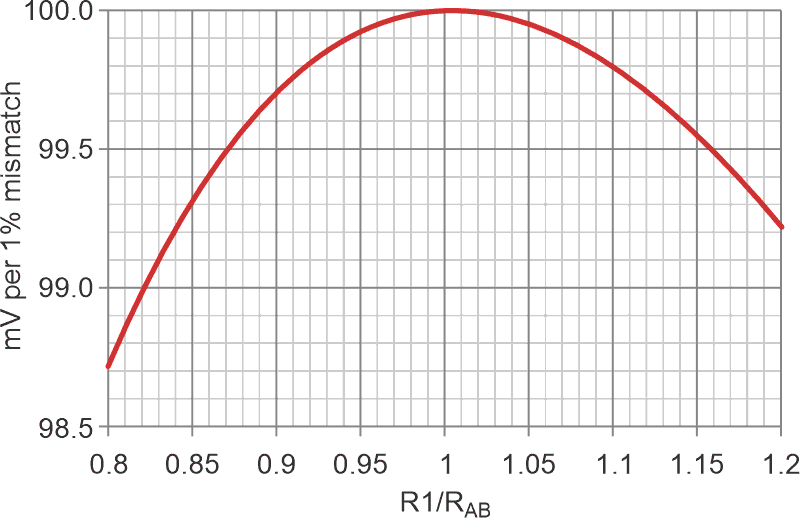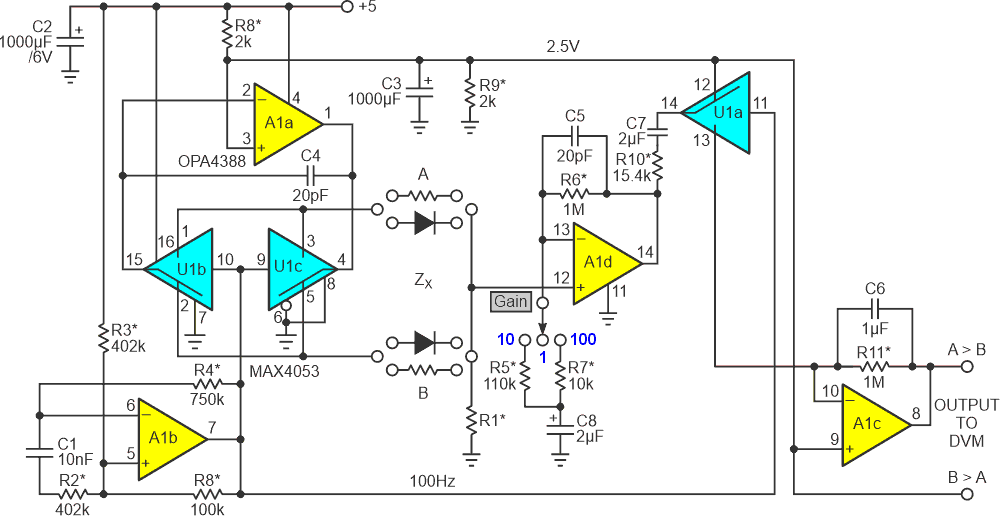Precision-matched resistors, diode pairs, and bridges are generic items. But sometimes an extra critical application with extra tight tolerances (or an extra tight budget) can dictate a little (or a lot) of DIY.
Figure 1’s matchmaker circuit can help make the otherwise odious chore of searching through a batch of parts for accurately matching pairs of resistors (or diodes) quicker and a bit less taxing. Best of all, it does precision (potentially to the ppm level) matchmaking with no need for pricey precision reference components.
Matchmaker’s A1a and U1bc generate a precisely symmetrical square-wave excitation (timed by the 100-Hz multivibrator A1b) to measure the mismatch between test parts A and B. The resulting difference signal is boosted by preamp A1d in switchable gains of 1, 10, or 100, synchronously demodulated by U1a, then filtered to DC with a final calibrating gain of 16x by A1c.
The key to Matchmaker’s precision is the Kelvin-style connection topology of the CMOS switches U1b and U1c. U1b, because it carries no significant load current (nothing but the pA-level input bias current of A1a), introduces only nanovolts of error. Meanwhile, the resulting sensing of excitation voltage level at the parts being matched, and the cancellation of U1c’s max 200-Ω on-resistance, is therefore exact, limited only by A1a’s gain-bandwidth at 100 Hz. Since the op-amp’s gain bandwidth (GBW) is ~10 MHz, the effective residual resistance is only 200/105 = 2 mΩ. Meanwhile, the 10-Ω max differential between the MAX4053 switches (the most critical parameter for excitation symmetry) is reduced to a usually insignificant 10/105 = 100 µΩ. The component lead wire and PWB trace resistance will contribute (much) more unless the layout is carefully done.
Matching resistors to better than ±1 ppm = 0.0001% is therefore possible. No ppm level references (voltage or resistance) need apply.
Output voltage as a function of RA/RB % mismatch is maximized when load resistor R1 is (at least approximately) equal to the nominal resistance of the resistances being matched. But because of the inflection maximum at R1/RAB = 1, that equality isn’t at all critical, as shown in Figure 2.
 |
|
| Figure 2. | The output level (mV per 1% mismatch at Gain = 1) is not sensitive to the exact value of R1/RAB. |
R1/RAB thus can vary from 1.0 by ±20% without disturbing mismatch gain by much more than 1%. However, R1 should not be less than ~50 Ω in order to stay within A1 and U1 current ratings.
Matchmaker also works to match diodes. In that case, R1 should be chosen to mirror the current levels expected in the application, R1 = 2 V / IAPP.
Due to what I attribute to an absolute freak of nature (for which I take no credit whatsoever), the output mV per 1% mismatch of forward diode voltage drop is (nearly) the same as for resistors, at least for silicon junction diodes.
Actually, there’s a simple explanation for the “freak of nature.” It’s just that a 1% differential between legs of the 2:1 RA/RB/R1 voltage divider is attenuated by 50% to become 1.25 V/100/2 = 6.25 mV, and 6.25 mV just happens to be very close to 1% of a silicon junction diode’s ~600 mV forward drop.
So, the freakiness really isn’t all that freaky, but it is serendipitous! Matchmaker also works with Schottky diodes, but due to their smaller forward drop, it will underreport their percent mismatch by about a factor of 3.
Due to the temperature sensitivity of diodes, it’s a good idea to handle them with thermally insulating gloves. This will save time and frustration waiting for them to equilibrate, not to mention possible, outright erroneous results. In fact, considering the possibility of misleading thermal effects (accidental dissimilar metal thermocouple junctions, etc.), it’s probably not a bad idea to wear gloves when handling resistors, too!
Happy ppm match making!
